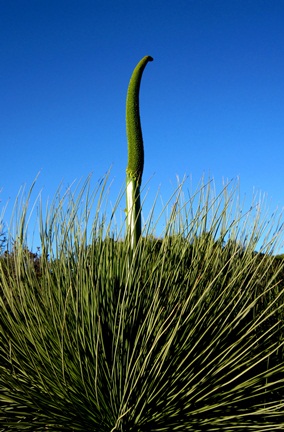Less water + a green garden = is it possible in Perth?
Posted on May 29, 2012 in Waterwise
Grasstree flower
By 2050 we may have only a quarter of the water available that we have today. (Based on predictions that population will double and water supply will diminish significantly)
So it makes sense to install a waterwise garden…..
In the past we have had an estate or park-like like design aesthetic with extensive lawns, whereas current landscape trends seem to be towards open, minimalistic landscapes dominated by hardscaping. We actually need to start thinking more like desert dwellers and create an ‘oasis’ like environment incorporating significantly more trees and hardy plants.
Check out our beautiful Australian flora, which over millennia has adapted to our soils and rainfall. There are many species which will give colour and interest throughout the year without supplementary watering.
There are also some wonderful Mediterranean plants which suit our climate and some very attractive succulents and sculptural plants which are worth including from a design point of view.
Plant productive gardens to feed your family but select drought tolerant species where possible.
Figs, grapes, olives, feijoa, pomegranate, guava, mulberry, nuts, pears, plums, apricots, quince, perennial herbs and veg. etc
If you would like to plant more water demanding fruit trees, citrus, banana, avocado, mango etc then consider installing a greywater system to effectively use your water twice.
Remember to:
Plant drought tolerant varieties where possible. Plant trees to provide shade and protection for smaller plants and try to reduce turf areas which are not functional. Avoid too much paving which creates heat traps and plant windbreaks against drying prevailing winds where necessary.
Improve soil with organic matter and if you have sandy soil consider adding clay which will aid water retention.
Mulch is essential and should consist of large irregular particles of a non-absorbent material – chipped tree waste, pine bark and gravel are all suitable. Mulch should be laid to a minimum depth of 50mm. It can reduce evaporation by as much as %70.
For irrigation, an appropriately designed drip system is preferable to sprinklers which lose water to wind drift and evaporation.
Turn your sprinklers off
The winter sprinkler ban commences at the start of June for three months and in autumn and spring the temperatures are cooler so minimal watering is required unless you are establishing new plants, growing vegies etc.
Any savings made in these seasons take the pressure off our water supply for when it is really needed , during our long, hot summer when there is little to no rainfall.


